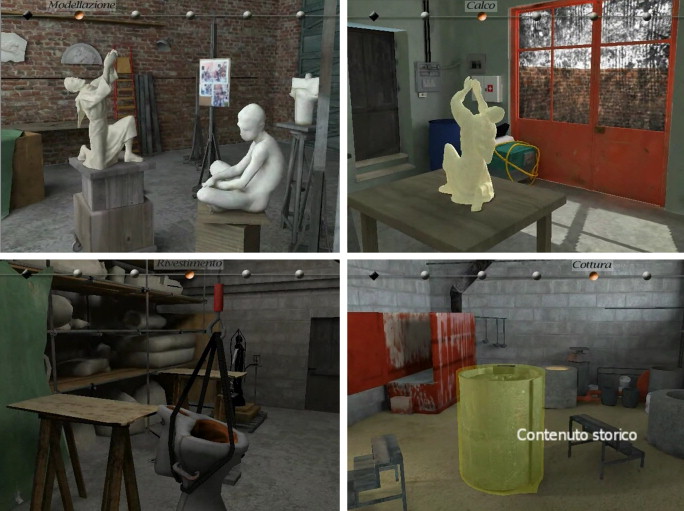Artistic handicraft is considered to all intents and purposes an important part of Cultural Heritage. The idea of creating a multimedia platform to communicate the tradition of artistic handicraft in Lucchesia (Tuscany, Italy) was born in order to preserve the memory of activities which have contributed in defining this region in terms of history, culture, peculiarity and quality of its products. The town of Pietrasanta, in particular, is well renowned for its artisans, who have been handing down ancient practices for ages, especially in the workmanship of marble and bronze. Our project aims at the valorisation and the communication of the bronze “investment casting” ancient technique through a 3D virtual interactive platform. This platform offers therefore a contribution to preserve this heritage and its memory, by means of a virtual experience inside the processes and the places where bronze sculptures are made. Users can follow from the beginning how such an artwork is created, dwelling on each step of the creation process and analyzing in details its main points.
In the same fashion as the bronze handicraft workflow, which is subdivided in various phases, the application consists of five stages each set in a different 3D virtual environment evocative, with its materials and tools, of the place where the work is performed. Each phase is introduced by a short video clip explaining how the artwork is processed and which operations are performed in it. The subdivision of the working phases, and consequently of the virtual stages (Fig. 2), has been chosen in order to replicate the typical alternation of negative and positive copies of the original.
The navigation begins with an introductory phase where the investment casting is historically and artistically contextualized, giving the user the possibility to familiarize with the topic and the virtual environment. After this “passive” introduction, the 3D environment becomes interactive and users are allowed to select some hotspots triggering various events, like the visualization of documents, the activation of other interactive sections and so on.
The different interactive environments are therefore virtual rooms, each representing and explaining a corresponding phase of the sculpture creation, which the user can move through selecting particular sensitive areas. These areas triggers informative material like text, graphics or movies either related to historical or technical aspects, plus an “exit” (a door, a sign or other similar well recognizable elements) to the next stage. The progression among the stages is therefore linear, allowing users to follow the entire creation process with a guided exploration approach using an interaction kept very simple, so as to let people not experienced with VR to quickly get used in the experience.
An interesting point is that the virtual environment is not only itself a source of information – by means of its 3D components which, reproducing real elements of the working environments, have a per se significant meaning in the context – but also a container of information of other types. Indeed, explanatory movies, recorded during our tour in local foundries, are shown embedded in the 3D context (Fig. 3), as if each component of the 3D environment (like curtains, walls, easels) might act as a projection surface.
With this approach, users do not have to perceptually switch context when accessing 2D or 3D information, and the overall sense of immersion in the virtual environment is therefore greatly improved.
Due to its specific nature, the handicraft process tends to remain isolated in its own workshop entrusting its survival to the passage of knowledge from artisan to artisan. This important artistic process which concentrates the ability of masters and the history of the territory, and, therefore, is indeed a complete cultural asset, runs the risk to be lost in a very few decades.
Knowledge and skills passed through the ages are likely to seem obsolete in a world where information spreads quickly, globally, and often superficially, considering also the wide diffusion of technologies that get us used to the homologation and the simplification of processes in the everyday life. Indeed, the latest years have seen a growth of events and projects aiming at the safeguard and the promotion of handicraft tradition, strong signals of lively attention towards a world whose value is increasing proportionally to its risk of going lost. In this sense new technologies are, on the other side, becoming a precious tool for the valorization of this knowledge, providing appealing and novel approaches to its preservation.
Analysis
Artistic handicraft is different from other kinds of cultural heritage. The process of making the craft is more important than the product itself. Preserving the process in the virtual world could keep realistic data for making technology. It could also increase some interesting experience for the tutorism. However, without an actual inheritor and market need, the sustainability question is still exist.




